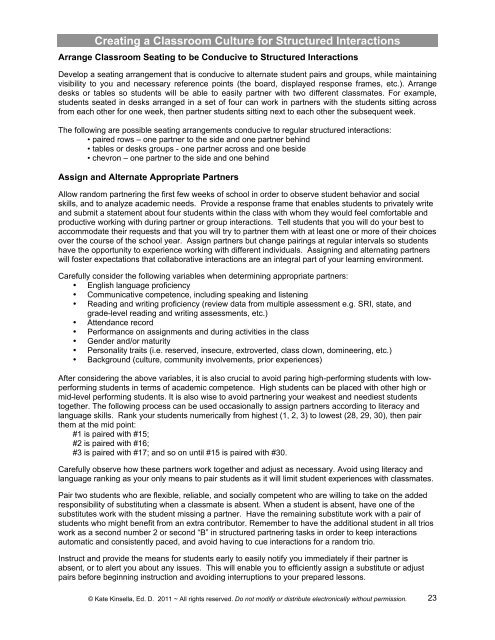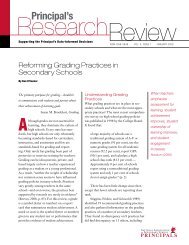Kate Kinsella, Ed.D. - eStaffRoom - Santa Clara County Office of ...
Kate Kinsella, Ed.D. - eStaffRoom - Santa Clara County Office of ...
Kate Kinsella, Ed.D. - eStaffRoom - Santa Clara County Office of ...
Create successful ePaper yourself
Turn your PDF publications into a flip-book with our unique Google optimized e-Paper software.
Creating a Classroom Culture for Structured InteractionsArrange Classroom Seating to be Conducive to Structured InteractionsDevelop a seating arrangement that is conducive to alternate student pairs and groups, while maintainingvisibility to you and necessary reference points (the board, displayed response frames, etc.). Arrangedesks or tables so students will be able to easily partner with two different classmates. For example,students seated in desks arranged in a set <strong>of</strong> four can work in partners with the students sitting acrossfrom each other for one week, then partner students sitting next to each other the subsequent week.The following are possible seating arrangements conducive to regular structured interactions:• paired rows – one partner to the side and one partner behind• tables or desks groups - one partner across and one beside• chevron – one partner to the side and one behindAssign and Alternate Appropriate PartnersAllow random partnering the first few weeks <strong>of</strong> school in order to observe student behavior and socialskills, and to analyze academic needs. Provide a response frame that enables students to privately writeand submit a statement about four students within the class with whom they would feel comfortable andproductive working with during partner or group interactions. Tell students that you will do your best toaccommodate their requests and that you will try to partner them with at least one or more <strong>of</strong> their choicesover the course <strong>of</strong> the school year. Assign partners but change pairings at regular intervals so studentshave the opportunity to experience working with different individuals. Assigning and alternating partnerswill foster expectations that collaborative interactions are an integral part <strong>of</strong> your learning environment.Carefully consider the following variables when determining appropriate partners:• English language pr<strong>of</strong>iciency• Communicative competence, including speaking and listening• Reading and writing pr<strong>of</strong>iciency (review data from multiple assessment e.g. SRI, state, andgrade-level reading and writing assessments, etc.)• Attendance record• Performance on assignments and during activities in the class• Gender and/or maturity• Personality traits (i.e. reserved, insecure, extroverted, class clown, domineering, etc.)• Background (culture, community involvements, prior experiences)After considering the above variables, it is also crucial to avoid paring high-performing students with lowperformingstudents in terms <strong>of</strong> academic competence. High students can be placed with other high ormid-level performing students. It is also wise to avoid partnering your weakest and neediest studentstogether. The following process can be used occasionally to assign partners according to literacy andlanguage skills. Rank your students numerically from highest (1, 2, 3) to lowest (28, 29, 30), then pairthem at the mid point:#1 is paired with #15;#2 is paired with #16;#3 is paired with #17; and so on until #15 is paired with #30.Carefully observe how these partners work together and adjust as necessary. Avoid using literacy andlanguage ranking as your only means to pair students as it will limit student experiences with classmates.Pair two students who are flexible, reliable, and socially competent who are willing to take on the addedresponsibility <strong>of</strong> substituting when a classmate is absent. When a student is absent, have one <strong>of</strong> thesubstitutes work with the student missing a partner. Have the remaining substitute work with a pair <strong>of</strong>students who might benefit from an extra contributor. Remember to have the additional student in all trioswork as a second number 2 or second “B” in structured partnering tasks in order to keep interactionsautomatic and consistently paced, and avoid having to cue interactions for a random trio.Instruct and provide the means for students early to easily notify you immediately if their partner isabsent, or to alert you about any issues. This will enable you to efficiently assign a substitute or adjustpairs before beginning instruction and avoiding interruptions to your prepared lessons.© <strong>Kate</strong> <strong>Kinsella</strong>, <strong>Ed</strong>. D. 2011 ~ All rights reserved. Do not modify or distribute electronically without permission.23






